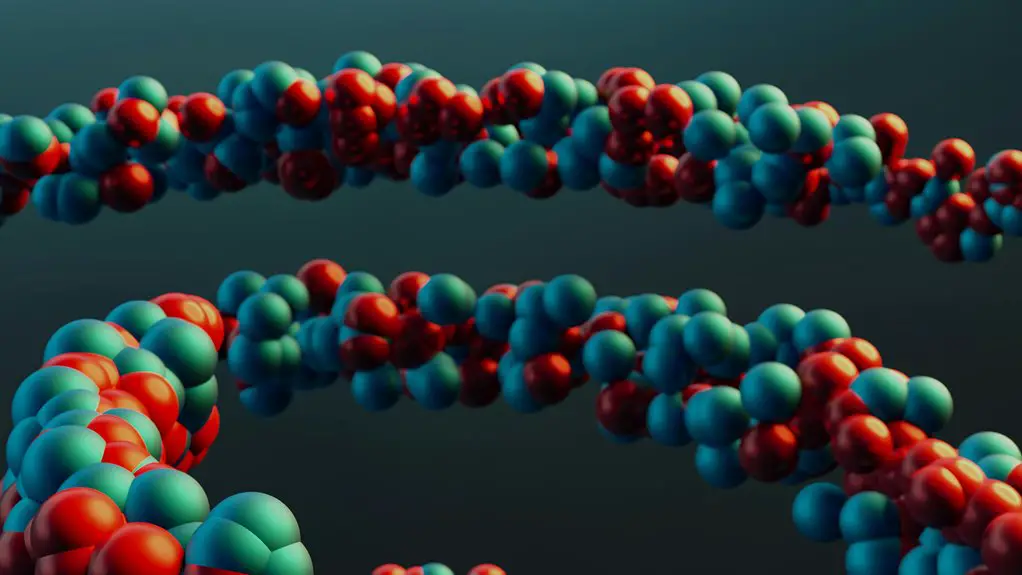Yes, polyamide is a condensation polymer formed when you combine diamines and dicarboxylic acids, creating strong amide bonds while releasing water molecules. This linking process, unlike addition polymers that retain their atoms, involves a chemical reaction where small molecules are lost, giving polyamides unique durability and heat resistance. These properties make them ideal for textiles, automotive parts, and more. Keep going, and you’ll uncover how their structure and chemistry influence these versatile uses.
Table of Contents
Key Takeaways
- Polyamides are condensation polymers formed by linking monomers with amide bonds, releasing water as a byproduct.
- They result from the reaction between diamines and dicarboxylic acids in a condensation polymerization process.
- The repeating unit in polyamides contains amide linkages (-CONH-), characteristic of condensation polymer structures.
- Polyamides differ from addition polymers as they lose small molecules (e.g., water) during polymerization.
- Common polyamides include Nylon 6 and Nylon 6,6, both synthesized through condensation reactions.
What Defines a Condensation Polymer?
A condensation polymer forms when monomers join together by releasing small molecules like water or methanol. When you connect these monomers, each bond formation kicks out a tiny molecule as a byproduct.
This process contrasts with addition polymerization, where monomers link without losing any atoms. You’ll notice that condensation polymers often involve functional groups like hydroxyl, carboxyl, or amine groups reacting with each other.
The repeated elimination of small molecules during chain growth defines the polymer’s structure and properties. Understanding this mechanism helps you grasp why condensation polymers typically have different characteristics compared to other polymers.
Chemical Structure of Polyamides
Although polyamides come in various forms, their chemical structures all share a common feature: repeating amide linkages (-CONH-) that connect monomer units. These linkages form strong hydrogen bonds, giving polyamides their notable strength and thermal resistance. You’ll often encounter nylon types distinguished by the number of carbon atoms in their monomers, affecting properties like flexibility and melting point.
| Polyamide Type | Monomer Units | Key Property |
|---|---|---|
| Nylon 6,6 | Hexamethylene + Adipic acid | High tensile strength |
| Nylon 6 | Caprolactam | Good elasticity |
| Nylon 11 | Undecanoic acid | Excellent chemical resistance |
| Nylon 12 | Dodecanoic acid | Low moisture absorption |
Understanding these structures helps you grasp why polyamides perform well in diverse applications.
The Polymerization Process of Polyamides
When you plunge into the polymerization process of polyamides, you’ll see how monomers link through condensation or ring-opening reactions to form long chains.
Typically, this involves diamines reacting with dicarboxylic acids, releasing water molecules as byproducts. Each amine group bonds with a carboxyl group, creating strong amide linkages that define polyamide’s structure.
Alternatively, you might encounter ring-opening polymerization, where cyclic monomers like lactams open up and connect sequentially without small molecule loss.
Both methods let you control molecular weight and polymer properties by adjusting reaction conditions. This precision is why polyamides are so versatile, used in textiles, automotive parts, and more.
Understanding this process helps you appreciate how these polymers achieve their strength, flexibility, and durability through carefully orchestrated chemical reactions.
Differences Between Condensation and Addition Polymers
Since polymers form through different chemical pathways, understanding the differences between condensation and addition polymers is key to grasping their unique properties.
When you work with condensation polymers, you’ll notice that each time monomers link together, a small molecule like water is released. This stepwise process often involves two different functional groups reacting, which means the polymer grows while losing byproducts.
On the other hand, addition polymers form by simply joining monomers with double bonds, without producing any byproducts. This reaction usually involves one type of monomer and proceeds quickly through free radical or ionic mechanisms.
Role of Amide Bonds in Polyamide Formation
You’ll find that amide bonds play a vital role in building polyamide chains.
These bonds form when a carboxyl group reacts with an amine group, creating strong linkages between monomers.
Understanding this mechanism helps you see how the polymer’s structure gains its strength and stability.
Amide Bond Structure
Although the amide bond might seem simple, it plays an essential role in forming polyamides by linking monomers into long, stable chains. This bond forms between a carbonyl group (C=O) of one monomer and an amine group (–NH2) of another.
You’ll find that the amide bond has a partial double-bond character due to resonance, which restricts rotation and adds rigidity to the polymer chain. This structure not only stabilizes the chain but also influences the polyamide’s physical properties, like melting point and strength.
When you examine the bond closely, you’ll notice the nitrogen’s lone pair delocalizes into the carbonyl group, creating a planar and robust linkage. Understanding this structure helps you grasp why polyamides are durable and widely used in textiles and engineering materials.
Formation Mechanism
The amide bond’s unique structure sets the stage for how polyamides form through a stepwise chemical process.
When you combine diamines and dicarboxylic acids, the amine group (-NH2) reacts with the carboxyl group (-COOH), releasing a water molecule and creating a strong amide linkage (-CONH-). This condensation reaction repeats, gradually building long polymer chains.
You’ll see that the stability of the amide bond helps the polymer resist breaking down under heat and chemical stress. As you follow the reaction, each step depends on the formation of these bonds, which act as the building blocks connecting monomers.
Understanding this mechanism helps you appreciate how polyamides gain their characteristic strength and durability through the continual formation of amide bonds.
Polymer Chain Linkage
Because amide bonds serve as the essential links between monomers, they directly shape the structure and properties of polyamide chains. When you look at these bonds, you see how they connect repeating units, creating strong, stable chains. These linkages influence everything from strength to flexibility.
Here’s what you should know about the role of amide bonds in polyamide formation:
- They form through a condensation reaction, releasing water.
- Each bond links a carboxyl group to an amine group.
- Amide bonds create a rigid backbone, enhancing durability.
- They allow hydrogen bonding between chains, increasing tensile strength.
- The arrangement of these bonds affects thermal resistance and elasticity.
Understanding these linkages helps you grasp why polyamides perform so well in textiles and engineering plastics.
Common Types of Polyamides and Their Applications
You’ll find several nylon variants, like Nylon 6 and Nylon 6,6, each offering unique properties.
These polyamides are widely used in industries ranging from textiles to automotive parts.
Understanding their applications will help you see why polyamides are so versatile.
Nylon Variants Overview
Although polyamides come in many forms, nylon variants stand out for their versatility and widespread use.
When you explore nylon types, you’ll see each has unique properties tailored for specific needs.
Here are some common nylon variants:
- Nylon 6: Known for toughness and elasticity; great for textiles and automotive parts.
- Nylon 6,6: Offers higher melting point and strength; used in industrial applications.
- Nylon 11: Derived from renewable sources; flexible and resistant to chemicals.
- Nylon 12: Lightweight with low moisture absorption; ideal for precision parts.
- Nylon 4,6: High heat resistance; used in electrical and mechanical components.
Understanding these variants helps you choose the right type for your projects efficiently.
Polyamide Application Areas
Polyamides serve a wide range of industries thanks to their diverse properties and durability.
When you choose Nylon 6 or Nylon 6,6, you’ll find them ideal for textiles, automotive parts, and industrial components due to their strength and resistance to wear.
Nylon 12, on the other hand, offers excellent chemical resistance and flexibility, making it perfect for fuel lines and medical devices.
You can also rely on aromatic polyamides, like Kevlar, for applications requiring exceptional toughness and heat resistance, such as body armor and aerospace parts.
Advantages of Polyamides as Condensation Polymers
Because they combine strength with flexibility, polyamides offer several advantages as condensation polymers. When you work with polyamides, you’ll notice their excellent durability and resistance, making them perfect for demanding applications.
They also handle heat well, which means they maintain performance under high temperatures. Plus, their chemical resistance protects against oils and solvents, so your materials last longer.
You’ll find that polyamides have good wear resistance, reducing maintenance needs. Finally, their ability to be molded into complex shapes gives you design freedom.
Here’s what you can expect:
- High tensile strength and flexibility
- Thermal stability over a wide range
- Resistance to chemicals and solvents
- Excellent abrasion and wear resistance
- Easy processing into various forms
These advantages make polyamides a reliable choice for many uses.
Frequently Asked Questions
How Are Polyamides Recycled or Disposed of Safely?
You can recycle polyamides by melting and reshaping them, or use chemical recycling to break them down. For safe disposal, avoid burning; instead, use designated recycling centers or programs to minimize environmental impact.
What Are Common Environmental Impacts of Polyamide Production?
You’ll find that polyamide production often releases greenhouse gases, consumes lots of energy, and generates chemical waste. These impacts can harm air and water quality, so it’s important you support sustainable manufacturing methods.
Can Polyamides Be Blended With Other Polymers?
Like mixing colors on an artist’s palette, you can blend polyamides with other polymers to create materials with unique properties. You’ll enhance flexibility, strength, or chemical resistance, tailoring blends for specific applications and performance needs.
How Do Temperature Changes Affect Polyamide Properties?
You’ll find that temperature changes impact polyamide’s flexibility and strength. As it heats, it softens and becomes more pliable; when cooled, it hardens and gains stiffness, affecting its durability and performance in different environments.
Are Polyamides Biodegradable or Eco-Friendly?
You might think polyamides are eco-friendly, but they’re not easily biodegradable. While some bio-based variants exist, most polyamides persist in the environment, so you’ll need to contemplate recycling or alternatives for greener choices.
- How Fire Resistant Is Polyamide? Flammability and Safety Ratings - June 30, 2025
- Chemistry Explained: the Polymerization of Hexamethylene Diamine Into Polyamide - June 30, 2025
- Which of These Is NOT a Polyamide? (A Chemistry Quiz) - June 30, 2025







